A Glorious Day Visiting Hahn Family Wines
by Susan Montgomery
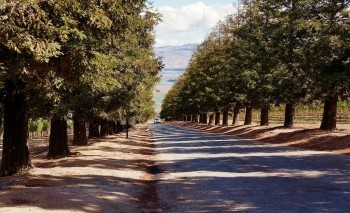 It was an idyllic fall day when we traveled with a group of wine writers to the gorgeous Santa Lucia Highlands, located near picturesque Carmel-by-the-Sea in Monterey County on the central coast of California.
It was an idyllic fall day when we traveled with a group of wine writers to the gorgeous Santa Lucia Highlands, located near picturesque Carmel-by-the-Sea in Monterey County on the central coast of California.
Many factors combine to make Santa Lucia Highlands perfect for growing grapes, including elevations of up to 1200 feet, ancient alluvial soil that drains well, fog that rolls in each morning, ocean breezes from Monterey Bay in the afternoons, and moderate temperatures with narrow differentials between high and low. The area also has special, intense light, because of reflections from the ocean that help to nurture the growing grapes. The notoriously temperamental Pinot Noir grape thrives in this special terroir.
Despite the drought in California, the area is nourished by an enormous underground aquifer supplied by the Salinas River so water supply is not a problem for the region.
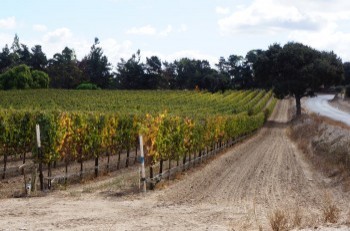 Although grapes were actually planted in this fertile region by Spanish missionaries in the 1790s, the land was primarily devoted to sheep and cattle grazing during the two hundred years before Nicholas Hahn purchased land in the area and planted grapes in the 1970s. The entire Santa Lucia Highlands’ grape-growing region has grown exponentially since then. Thanks in great part to the efforts of Hahn and a few other pioneering grape growers, the area was designated in 1991 as an AVA (American Viticultural Area). Today the region has more than 6000 acres of vineyards and 46 vineyard estates on its rolling hills.
Although grapes were actually planted in this fertile region by Spanish missionaries in the 1790s, the land was primarily devoted to sheep and cattle grazing during the two hundred years before Nicholas Hahn purchased land in the area and planted grapes in the 1970s. The entire Santa Lucia Highlands’ grape-growing region has grown exponentially since then. Thanks in great part to the efforts of Hahn and a few other pioneering grape growers, the area was designated in 1991 as an AVA (American Viticultural Area). Today the region has more than 6000 acres of vineyards and 46 vineyard estates on its rolling hills.
 It was appropriate that we were visiting Hahn Family Wines, one of the largest grape producers in the AVA, which is now overseen by Nicholas Hahn’s son, Philip. In the Santa Lucia AVA, Hahn has planted more than 650 acres, more than 10 percent of the total acreage planted in the AVA. In the nearby Arroyo Seco AVA, Hahn has planted an additional 461 acres.
It was appropriate that we were visiting Hahn Family Wines, one of the largest grape producers in the AVA, which is now overseen by Nicholas Hahn’s son, Philip. In the Santa Lucia AVA, Hahn has planted more than 650 acres, more than 10 percent of the total acreage planted in the AVA. In the nearby Arroyo Seco AVA, Hahn has planted an additional 461 acres.
After arriving at Hahn, we took a breath-taking ATV tour up to the top of a steep hill overlooking the vineyards where we sipped superb wines paired with elegant appetizers. I highly recommend one of these tours as the best way to grasp the overwhelming beauty and scope of the winery’s sweeping estate.
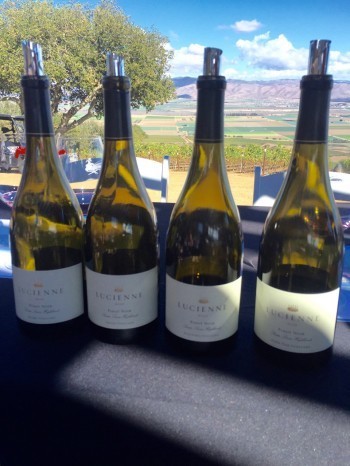 The Hahn wines we tasted during our visit were well-balanced, with memorable, distinct flavors, good acidity and nice minerality. The Hahn SLH label, reflecting the best of Santa Lucia grapes, includes estate Pinot Noir and Chardonnay. The Lucienne label includes outstanding Pinot Noir and Chardonnay wines produced from single vineyards. Several varietals, including Pinot Noir, Chardonnay, Pinot Gris, Cabernet Sauvignon, GSM and Merlot, are also produced under the basic Hahn label. Many Hahn wines have won prestigious awards and receive high point ratings from Wine Spectator and other publications.
The Hahn wines we tasted during our visit were well-balanced, with memorable, distinct flavors, good acidity and nice minerality. The Hahn SLH label, reflecting the best of Santa Lucia grapes, includes estate Pinot Noir and Chardonnay. The Lucienne label includes outstanding Pinot Noir and Chardonnay wines produced from single vineyards. Several varietals, including Pinot Noir, Chardonnay, Pinot Gris, Cabernet Sauvignon, GSM and Merlot, are also produced under the basic Hahn label. Many Hahn wines have won prestigious awards and receive high point ratings from Wine Spectator and other publications.
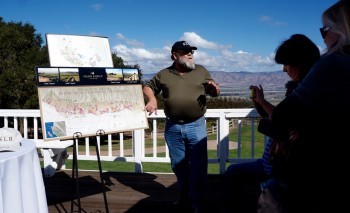 Hahn’s Director of Viticulture, Andy Mitchell (right), and winemaker, Greg Freeman (below, right), talked with us about the distinct terroir differences among Hahn’s four estate vineyards. Each vineyard has its own micro-climate with differences in elevation, wind, sun and fog that result in unique grape and wine characteristics. We were able to taste wines from each of these vineyards and could definitely tell the differences among them.
Hahn’s Director of Viticulture, Andy Mitchell (right), and winemaker, Greg Freeman (below, right), talked with us about the distinct terroir differences among Hahn’s four estate vineyards. Each vineyard has its own micro-climate with differences in elevation, wind, sun and fog that result in unique grape and wine characteristics. We were able to taste wines from each of these vineyards and could definitely tell the differences among them..jpg)
Because the most northern vineyard, Lone Oak Vineyard, is at a lower elevation, it has more fog, less wind and is a few degrees cooler. Since wind makes grape skins thicker, Lone Oak’s grapes have thinner skins that result in lighter, silky wines with less tannins. Hook Vineyard has less fog and wind and is warmer than Lone Oak. Its 14 clones of Pinot Noir produce a bold, fruity wine with smoky overtones and moderate tannins. Wines from these grapes are crispy, earthy and spicy. Doctor’s Vineyard is higher and gets more sun and also more wind during the day. Because of its thicker skin, it produces wines that are rich in cherry and strawberry flavors with more intense tannins. Smith Vineyard is even further up the hill above the fog levels and receives lots of sunshine. Its grapes produce wines that are tannic, intense, and full of deep berry tastes.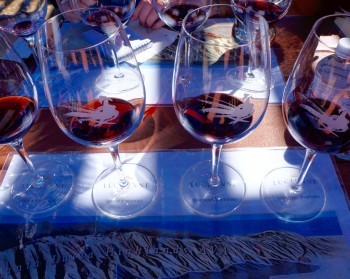
Sustainability is a major goal in Hahn’s grape growing process. Hahn’s vineyards are certified under the rigorous Sustainability in Practice standards, which means special attention is paid to water and soil conservation, efficient energy use, and natural pest management.
.jpg) Hahn’s Director of Winemaking, Paul Clifton, and Winemaker, Greg Freeman, collaborate to produce the best wines possible. Grapes are harvested at the peak of ripeness and then are pressed and cold soaked before fermentation in French Oak. Each clone is harvested and fermented separately and each produces distinct flavors. The winemakers also like experimenting with yeast to produce different aromas and flavors. (And sometimes Winemaker Greg Freeman encourages the fermentation process with a few tunes on his bagpipes.)
Hahn’s Director of Winemaking, Paul Clifton, and Winemaker, Greg Freeman, collaborate to produce the best wines possible. Grapes are harvested at the peak of ripeness and then are pressed and cold soaked before fermentation in French Oak. Each clone is harvested and fermented separately and each produces distinct flavors. The winemakers also like experimenting with yeast to produce different aromas and flavors. (And sometimes Winemaker Greg Freeman encourages the fermentation process with a few tunes on his bagpipes.)
During our visit we had the opportunity to taste some of Hahn’s meticulously crafted wines paired with exquisite dishes prepared by Chef Dyon Foster and his staff. We discovered how well these wines match with food. Every taste was better when accompanied by a sip of Hahn wine.
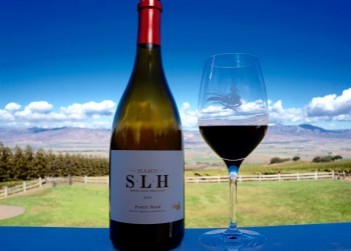 After our ATV ride, as we gazed in awe from the top of a hill at the beautiful expanse of Hahn vineyards below, we tasted four outstanding Pinot Noirs, including a fruity, rich 2013 Lucienne from the “Smith Vineyard,” paired with crispy duck confit tacos. Before lunch, we were greeted with a crisp, refreshing 2014 Hahn Pinot Gris. With a delicious course of delectable sablefish served over risotto with a savory beurre noisette sauce, we enjoyed Hahn’s creamy, floral 2013 SLH Chardonnay.
After our ATV ride, as we gazed in awe from the top of a hill at the beautiful expanse of Hahn vineyards below, we tasted four outstanding Pinot Noirs, including a fruity, rich 2013 Lucienne from the “Smith Vineyard,” paired with crispy duck confit tacos. Before lunch, we were greeted with a crisp, refreshing 2014 Hahn Pinot Gris. With a delicious course of delectable sablefish served over risotto with a savory beurre noisette sauce, we enjoyed Hahn’s creamy, floral 2013 SLH Chardonnay. .jpg) Next Hahn’s 2013 SLH Pinot Noir, with intense flavors of berries and mocha, enhanced flavorful pork medallions served atop cranberry and corn polenta. And finally a full-bodied 2013 Smith & Hook Cabernet Sauvignon with bold berry tastes was an ideal match with our final course of cheese and roasted almonds.
Next Hahn’s 2013 SLH Pinot Noir, with intense flavors of berries and mocha, enhanced flavorful pork medallions served atop cranberry and corn polenta. And finally a full-bodied 2013 Smith & Hook Cabernet Sauvignon with bold berry tastes was an ideal match with our final course of cheese and roasted almonds.
Hahn wines are available through the winery’s website or in their tasting room which is open daily from 11 a.m. until 5 p.m., except for major holidays. ATV tours are offered to the public daily for $45 a person and include tastes of some stellar wines. Walking tours are also available for $25. Reservations are required for either tour.
If you are going to visit Carmel or Monterey, make sure you take the time to tour the nearby Santa Lucia Highlands and stop by Hahn Family Wines for an exceptional experience.
Right: Our group of wine writers at the top of a hill at Hahn Family Wines.
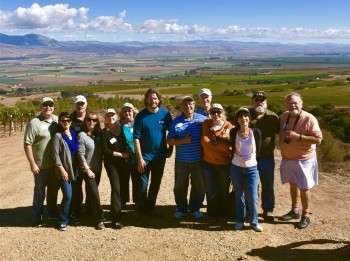
Photos with this article taken by Todd Montgomery.

